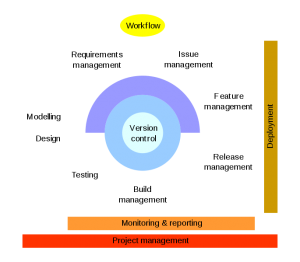Open Source Application Lifecycle Management
 SOS Open Source formerly has been asked to choose a web project management platform first and then to identify an open source software configuration management tool. The ultimate goal was to assemble an open source Application Lifecycle Management suite.
SOS Open Source formerly has been asked to choose a web project management platform first and then to identify an open source software configuration management tool. The ultimate goal was to assemble an open source Application Lifecycle Management suite.
This article is a short essay on a journey about how to select the right components and then integrating them to create an effective development platform.
Version Control Systems.
Our customer was looking for centralized SCM, where all the revision control functions take place on a shared server, so we didn’t go through evaluations around which is the best approach (distributed or centralized).
We easily jumped to the conclusion that Subversion could be a better option than CVS, given CVS status and known open issues, then we used SOS Open Source tools to look deeper into the Subversion project.
 Subversion, historically developed and sponsored by CollabNet, recently was first submitted to Apache Incubator and later became an Apache top level project. The code base it is stable and mature (over 10 years old!), and keeps growing. Subversion, historically known as one of the most popular version control systems, is at the center of many books, and in the net you can find many case studies.
Subversion, historically developed and sponsored by CollabNet, recently was first submitted to Apache Incubator and later became an Apache top level project. The code base it is stable and mature (over 10 years old!), and keeps growing. Subversion, historically known as one of the most popular version control systems, is at the center of many books, and in the net you can find many case studies.
Subversion is highly sustainable, it is a community-led project governed by a foundation, actively developed by over 30 developers, placing Subversion in the top 2% of all project teams available on Ohloh.
Subversion Industrial Strength is unexceptionable. Documentation is detailed, but it is available only in English. Subversion it is mostly written in C (and Python), and is well commented. As every Apache project has in place tools (temporarily still at Tigris) and QA procedures. Thanks to the availability of a pre-packaged software stack named Collabnet Subversion Edge (including Subversion+Apache+ViewVC) that makes easy installation and administration. Commercial support is available from the author and others, same for consulting and training.
Subversion Project Strategy scored the highest possible mark: along with a best-of-breed architecture of participation comes a public detailed roadmap and a permissive license.
Subversion total score is very high, and having formerly tested Redmine SCM integrations we were confident that Subversion was a feasible choice.
Redmine lacks a BluePrint feature, a lightweight approach to track requirements from initial concept to implementation. In order to implement a similar feature we developed a Redmine plugin enabling users to write requirements and assign them to project’s leaders.
We crafted a plugin to allow Redmine’s users to assign activities to Groups, so that all developers working in the same group can work on those issues (a feature that probably our customer will give back to the community, since it maybe of general appeal).
Test case management and business intelligence reporting are actually done using other tools, and we are providing help also to identify a viable Single Sign solution to allow users to move seamless back and forth between different systems. Stay tuned for more.



